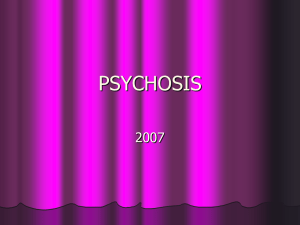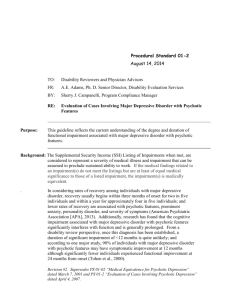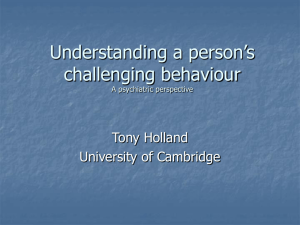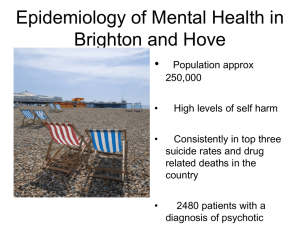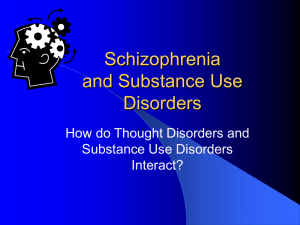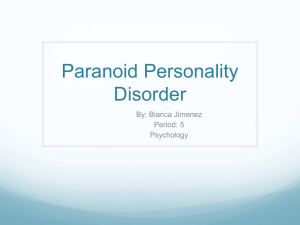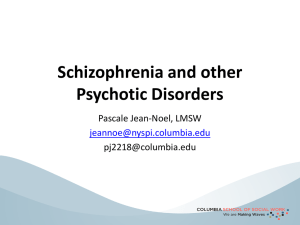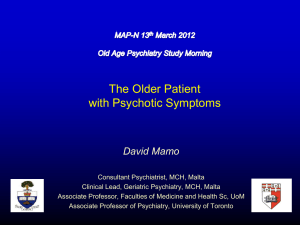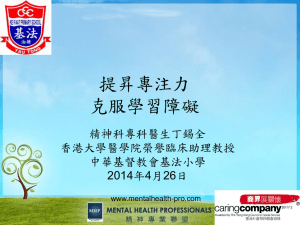Acute confusional state / post operative psychosis
advertisement
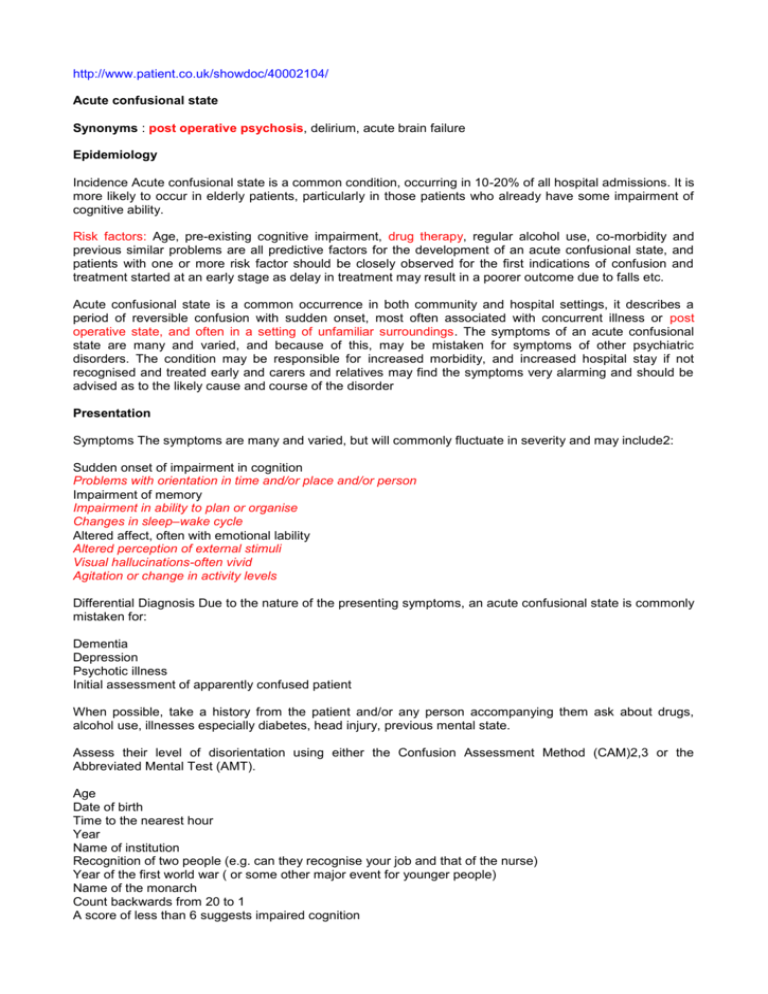
http://www.patient.co.uk/showdoc/40002104/ Acute confusional state Synonyms : post operative psychosis, delirium, acute brain failure Epidemiology Incidence Acute confusional state is a common condition, occurring in 10-20% of all hospital admissions. It is more likely to occur in elderly patients, particularly in those patients who already have some impairment of cognitive ability. Risk factors: Age, pre-existing cognitive impairment, drug therapy, regular alcohol use, co-morbidity and previous similar problems are all predictive factors for the development of an acute confusional state, and patients with one or more risk factor should be closely observed for the first indications of confusion and treatment started at an early stage as delay in treatment may result in a poorer outcome due to falls etc. Acute confusional state is a common occurrence in both community and hospital settings, it describes a period of reversible confusion with sudden onset, most often associated with concurrent illness or post operative state, and often in a setting of unfamiliar surroundings. The symptoms of an acute confusional state are many and varied, and because of this, may be mistaken for symptoms of other psychiatric disorders. The condition may be responsible for increased morbidity, and increased hospital stay if not recognised and treated early and carers and relatives may find the symptoms very alarming and should be advised as to the likely cause and course of the disorder Presentation Symptoms The symptoms are many and varied, but will commonly fluctuate in severity and may include2: Sudden onset of impairment in cognition Problems with orientation in time and/or place and/or person Impairment of memory Impairment in ability to plan or organise Changes in sleep–wake cycle Altered affect, often with emotional lability Altered perception of external stimuli Visual hallucinations-often vivid Agitation or change in activity levels Differential Diagnosis Due to the nature of the presenting symptoms, an acute confusional state is commonly mistaken for: Dementia Depression Psychotic illness Initial assessment of apparently confused patient When possible, take a history from the patient and/or any person accompanying them ask about drugs, alcohol use, illnesses especially diabetes, head injury, previous mental state. Assess their level of disorientation using either the Confusion Assessment Method (CAM)2,3 or the Abbreviated Mental Test (AMT). Age Date of birth Time to the nearest hour Year Name of institution Recognition of two people (e.g. can they recognise your job and that of the nurse) Year of the first world war ( or some other major event for younger people) Name of the monarch Count backwards from 20 to 1 A score of less than 6 suggests impaired cognition Look for any obvious cause e.g. head injury, hypothermia, dehydration, hip fracture, CVA, urinary retention Assess their general state, if clean and appropriately dresses this may suggest an acute problem Check temperature, pulse , BP and JVP Look for sources of infection e.g. chest infection, cellulitis Dip test urine for blood protein and sugar Check for hypoglycaemia FBC looking for raised white cell count and anaemia U+Es looking for electrolyte imbalance and dehydration Serum Calcium- hypercalcaemia may result in confusion +/- CXR even if no clinical signs of pneumonia Management Non-Drug Environmental factors are particularly important in the treatment of acute confusional state and the following factors are helpful in shortening the period of confusion. Continuity of care personnel i.e. the same nurse/doctor whenever possible Clear concise communication Repeated verbal reminders of time, place and person. Clock, calendar, TV, newspaper, radio readily accessible as a means of orientating in time Bedside lighting available and left on at night Simplify the environment, single room when available, reduce noise levels, remove unnecessary equipment Correct sensory impairment by ensuring the patient is wearing hearing aid/glasses/false teeth etc Allow maximum periods of uninterrupted sleep Allow patient to become involved in self care regime, decide level of analgesia etc. Encourage mobilisation and increase activity levels Drugs and other therapeutic measures Oxygen if cause uncertain or secondary to cardiac or respiratory problems 50 mls 50% glucose if hypoglycaemic Treat the underlying cause e.g. infection Drug treatment must only be used in conjunction with the environmental measures above, or otherwise may in some instances worsen the confusion. Early intervention with drugs when required is associated with lower overall drug use and better eventual outcome. Discontinue or change any drugs which may by contributing to the confusion as drugs are implicated in 1020% of cases. All drugs are capable of producing the state, but some are much more likely to produce problems e.g. narcotics, opiates, benzodiazepines and drugs with anticholinergic activity. Identify the reason for prescribing drugs, as benefits from decreased agitation may be associated with risks of longer periods of confusion or cognitive impairment. Antipsychotic agents such as chlorpromazine or haloperidol are commonly used in preference to benzodiazepines, and low doses of haloperidol are preferable to other agents due to a lower side effect profile4 Droperidol may be used if a fast onset of action and increased sedation is required. Olanzapine and respiridone have been used with some success and early studies suggest they are less sedating and have fewer side effects, but further controlled studies require to be performed.5 If it is felt that treatment with a benzodiazepine would be beneficial, then lorazepam is the drug of first choice due to it’s rapid onset of action and low side effect profile. Complications Acute confusional state can result in increased morbidity and increased length of hospital stay and use of care facilities on discharge if not recognised and treated early. Common problems occur as a result of falls, injury during periods of agitation, increase in problems from poor mobility secondary to sedation e.g. chest infections, pressure sores, pulmonary emboli and therefore early intervention with environmental factors+/- appropriate drug therapy is important in preventing secondary problems. Prognosis The prognosis will depend on the co-morbidities and the development of complications, but the majority of patients who develop an acute confusional state will in time, with good management, return to their pre-morbid state. Prevention In high risk patients, providing a consistent environment with readily available points of reference will help to avoid/lessen the degree of confusion. References Used Trzepacz PT; Delirium. Advances in diagnosis, pathophysiology, and treatment.;Psychiatr Clin North Am 1996 Sep;19(3):429-448. Inouye SK; The dilemma of delirium: clinical and research controversies regarding diagnosis and evaluation of delirium in hospitalized elderly medical patients.;Am J Med 1994 Sep;97(3):278-88. Schuurmans MJ, Deschamps PI, Markham SW, et al; The measurement of delirium: review of scales.;Res Theory Nurs Pract 2003 Fall;17(3):207-24. Hassan E, Fontaine DK, Nearman HS; Therapeutic considerations in the management of agitated or delirious critically ill patients.;Pharmacotherapy 1998 Jan-Feb;18(1):113-29. Meagher DJ; Delirium: optimising management.;BMJ 2001 Jan 20;322(7279):144-9. http://www.healthline.com/adamcontent/psychosis Definition Psychosis is a loss of contact with reality, typically including delusions (false ideas about what is taking place or who one is) and hallucinations (seeing or hearing things which aren't there). Alternative Names Psychotic Causes, incidence, and risk factors Psychosis is a severe mental condition characterized by a loss of contact with reality. There are numerous potential causes: Alcohol and certain drugs can induce psychosis Bipolar disorder (manic depression) Brain tumors Epilepsy Psychotic depression Schizophrenia Dementia (Alzheimer's and other degenerative brain disorders) Stroke Symptoms Loss of touch with reality Seeing, hearing, feeling, or otherwise perceiving things that are not there (hallucinations) Disorganized thought and/or speech Emotion is exhibited in an abnormal manner Extreme excitement (mania) Confusion Depression and sometimes suicidal thoughts Unfounded fear/suspicion Mistaken perceptions (illusions) False beliefs (delusions) Signs and tests Psychological evaluation and testing are used to diagnosis the cause of the psychosis. Laboratory or radiological testing may not be essential, but sometimes can help pinpoint the exact diagnosis. Tests may include: MRI of the brain Tests for syphilis Drug screens Treatment Treatment varies depending on the cause of the psychosis. Care in a hospital is often needed to ensure the patient's safety. Drugs that diminish auditory hallucinations ("hearing voices") and delusions, and stabilize thinking and behavior (antipsychotic drugs) are helpful. Group or individual therapy can also be useful. Expectations (prognosis) The expectations for the outcome vary with the specific disorder. Many of the symptoms can be controlled with long-term treatment. Complications Psychosis can prevent a person from functioning normally. During psychotic states, there can be an inability to care for oneself. If the condition is left untreated, there is a possibility of self-harm or harm to others. Calling your health care provider Call your health care provider or mental health professional if a member of your family exhibits behavior indicating a loss of contact with reality. If there is any concern about safety, as described above, immediately take the person to the nearest emergency room for evaluation. Prevention Prevention depends on the cause. For example, preventing alcohol abuse prevents alcohol-induced psychosis. http://www.healthline.com/galecontent/substance-induced-psychotic-disorder Substance-induced psychotic disorder Definition Prominent psychotic symptoms (i.e., hallucinationsand/or delusions) determined to be caused by the effects of a psychoactive substance is the primary feature of a substance-induced psychotic disorder. A substance may induce psychotic symptoms during intoxication (while the individual is under the influence of the drug) or during withdrawal (after an individual stops using the drug). Description A substance-induced psychotic disorder is subtyped or categorized based on whether the prominent feature is delusions or hallucinations. Delusions are fixed, false beliefs. Hallucinations are seeing, hearing, feeling, tasting, or smelling things that are not there. In addition, the disorder is subtyped based on whether it began during intoxication on a substance or during withdrawal from a substance. A substance-induced psychotic disorder that begins during substance use can last as long as the drug is used. A substance-induced psychotic disorder that begins during withdrawal may first manifest up to four weeks after an individual stops using the substance. Causes A substance-induced psychotic disorder, by definition, is directly caused by the effects of drugs including alcohol, medications, and toxins. Psychotic symptoms can result from intoxication on alcohol, amphetamines (and related substances), cannabis (marijuana), cocaine, hallucinogens, inhalants, opioids, phencyclidine (PCP) and related substances, sedatives, hypnotics, anxiolytics, and other or unknown substances. Psychotic symptoms can also result from withdrawal from alcohol, sedatives, hypnotics, anxiolytics, and other or unknown substances. Some medications that may induce psychotic symptoms include anesthetics and analgesics, anticholinergic agents, anticonvulsants, antihistamines, antihypertensive and cardiovascular medications, antimicrobial medications, antiparkinsonian medications, chemotherapeutic agents, corticosteroids, gastrointestinal medications, muscle relaxants, nonsteroidal anti-inflammatory medications, other over-the-counter medications, antidepressant medications, and disulfiram. Toxins that may induce psychotic symptoms include anticholinesterase, organophosphate insecticides, nerve gases, carbon monoxide, carbon dioxide, and volatile substances (such as fuel or paint). The speed of onset of psychotic symptoms varies depending on the type of substance. For example, using a lot of cocaine can produce psychotic symptoms within minutes. On the other hand, psychotic symptoms may result from alcohol use only after days or weeks of intensive use. The type of psychotic symptoms also tends to vary according to the type of substance. For instance, auditory hallucinations (specifically, hearing voices), visual hallucinations, and tactile hallucinations are most common in an alcohol-induced psychotic disorder, whereas persecutory delusions and tactile hallucinations (especially formication) are commonly seen in a cocaine- or amphetamine-induced psychotic disorder. Symptoms The Diagnostic and Statistical Manual of Mental Disorders (DSM-IV-TR) notes that a diagnosisis made only when the psychotic symptoms are above and beyond what would be expected during intoxication or withdrawal and when the psychotic symptoms are severe. Following are criteria necessary for diagnosis of a substance-induced psychotic disorder as listed in the DSMIV-TR: Presence of prominent hallucinations or delusions. Hallucinations and/or delusions develop during, or within one month of, intoxication or withdrawal from a substance or medication known to cause psychotic symptoms. Psychotic symptoms are not actually part of another psychotic disorder (such as schizophrenia, schizophreniform disorder, schizoaffective disorder) that is not substance induced. For instance, if the psychotic symptoms began prior to substance or medication use, then another psychotic disorder is likely. Psychotic symptoms do not only occur during delirium. Demographics Little is known regarding the demographics of substance-induced psychosis. However, it is clear that substance-induced psychotic disorders occur more commonly in individuals who abuse alcohol or other drugs. Diagnosis Diagnosis of a substance-induced psychotic disorder must be differentiated from a psychotic disorder due to a general medical condition. Some medical conditions (such as temporal lobe epilepsy or Huntington's chorea) can produce psychotic symptoms, and, since individuals are likely to be taking medications for these conditions, it can be difficult to determine the cause of the psychotic symptoms. If the symptoms are determined to be due to the medical condition, then a diagnosis of a psychotic disorder due to a general medical condition is warranted. Substance-induced psychotic disorder also needs to be distinguished from delirium, dementia, primary psychotic disorders, and substance intoxication and withdrawal. While there are no absolute means of determining substance use as a cause, a good patient history that includes careful assessment of onset and course of symptoms, along with that of substance use, is imperative. Often, the patient's testimony is unreliable, necessitating the gathering of information from family, friends, coworkers, employment records, medical records, and the like. Differentiating between substance-induced disorder and a psychiatric disorder may be aided by the following: Time of onset: If symptoms began prior to substance use, it is most likely a psychiatric disorder. Substance use patterns: If symptoms persist for three months or longer after substance is discontinued, a psychiatric disorder is probable. Consistency of symptoms: Symptoms more exaggerated than one would expect with a particular substance type and dose most likely amounts to a psychiatric disorder. Family history: A family history of mental illness may indicate a psychiatric disorder. Response to substance abuse treatment: Clients with both psychiatric and substance use disorders often have serious difficulty with traditional substance abuse treatment programs and relapse during or shortly after treatment cessation. Client's stated reason for substance use: Those with a primary psychiatric diagnosis and secondary substance use disorder will often indicate they "medicate symptoms," for example, drink to dispel auditory hallucinations, use stimulants to combat depression, use depressants to reduce anxiety or soothe a manic phase. While such substance use most often exacerbates the psychotic condition, it does not necessarily mean it is a substance-induced psychotic disorder. Unfortunately, psychological tests are not always helpful in determining if a psychotic disorder is caused by substance use or is being exacerbated by it. However, evaluations, such as the MMPI-2 MAC-R scale or the Wechsler Memory ScaleRevised, can be useful in making a differential diagnosis. Treatments Treatment is determined by the underlying cause and severity of psychotic symptoms. However, treatment of a substance-induced psychotic disorder is often similar to treatment for a primary psychotic disorder such as schizophrenia. Appropriate treatments may include psychiatric hospitalizationand antipsychotic medication. Prognosis Psychotic symptoms induced by substance intoxication usually subside once the substance is eliminated. Symptoms persist depending on the half-life of the substances (i.e., how long it takes the before the substance is no longer present in an individual's system). Symptoms, therefore, can persist for hours, days, or weeks after a substance is last used. Prevention There is very little documented regarding prevention of substance-induced psychotic disorder. However, abstaining from drugs and alcohol or using these substances only in moderation would clearly reduce the risk of developing this disorder. In addition, taking medication under the supervision of an appropriately trained physician should reduce the likelihood of a medication induced psychotic disorder. Finally, reducing one's exposure to toxins would reduce the risk of toxin-induced psychotic disorder.

